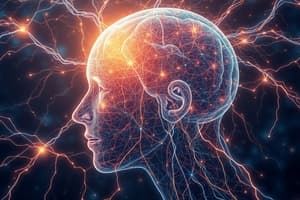Podcast
Questions and Answers
What is the characteristic of spasticity?
What is the characteristic of spasticity?
- Exaggerated stretch reflex associated with UMN lesion (correct)
- Involuntary movement patterns leading to decreased strength
- Sustained muscle contraction causing abnormal posturing
- Complete loss of muscle tone immediately after CNS injury
What is the main consequence of acute flaccidity after a CNS injury?
What is the main consequence of acute flaccidity after a CNS injury?
- Sustained muscle contraction causing abnormal posturing
- Involuntary movement patterns leading to decreased strength
- Exaggerated stretch reflex associated with UMN lesion
- Complete loss of muscle tone, requiring limb and joint protection (correct)
What is the characteristic of dystonia?
What is the characteristic of dystonia?
- Involuntary movement patterns leading to decreased strength
- Complete loss of muscle tone immediately after CNS injury
- Sustained muscle contraction causing abnormal posturing (correct)
- Exaggerated stretch reflex associated with UMN lesion
What is the primary characteristic of ataxia?
What is the primary characteristic of ataxia?
What are the main consequences of cerebral palsy?
What are the main consequences of cerebral palsy?
Which term describes the reacquisition of normal movement patterns after an injury or disease?
Which term describes the reacquisition of normal movement patterns after an injury or disease?
What is the process where neurons responsible for certain movement adapt by regenerating sprouts from adjacent neurons to recover lost function?
What is the process where neurons responsible for certain movement adapt by regenerating sprouts from adjacent neurons to recover lost function?
What term describes the experiences shaping the amount of neural acquisition to different parts of the brain?
What term describes the experiences shaping the amount of neural acquisition to different parts of the brain?
What is the term for the subconscious collection of motor programs that build motor plans and are hardwired like habits?
What is the term for the subconscious collection of motor programs that build motor plans and are hardwired like habits?
What term describes the brain's ability to shift and change based on activities learned or performed?
What term describes the brain's ability to shift and change based on activities learned or performed?
Which factors are crucial in motor learning according to the text?
Which factors are crucial in motor learning according to the text?
What are the 10 principles of Neuroplasticity primarily focused on according to the text?
What are the 10 principles of Neuroplasticity primarily focused on according to the text?
Which practice strategy is suitable for patients who fatigue easily, based on the text?
Which practice strategy is suitable for patients who fatigue easily, based on the text?
What can maximize motor learning and neuroplasticity, based on the text?
What can maximize motor learning and neuroplasticity, based on the text?
Which type of feedback provides information about the quality of the movement?
Which type of feedback provides information about the quality of the movement?
What type of injuries may result in increased tone and reflexes?
What type of injuries may result in increased tone and reflexes?
What are the cardinal signs of impairments resulting from a pathophysiological cause?
What are the cardinal signs of impairments resulting from a pathophysiological cause?
What type of feedback is chosen based on clinical decision making, patient status, and stage of motor learning?
What type of feedback is chosen based on clinical decision making, patient status, and stage of motor learning?
Which motor function intervention strategy includes general activity training and impairment-specific training?
Which motor function intervention strategy includes general activity training and impairment-specific training?
Flashcards are hidden until you start studying
Study Notes
Motor Function Feedback Strategies and Impediments
- Augmented feedback can be verbal, tactile, or using manual assistance, and can also involve biofeedback or computerized devices.
- There are nine types of extrinsic feedback, including concurrent-constant, terminal, immediate, delayed, summary, faded, bandwidth, blocked, and random or variable feedback.
- Knowledge of Results provides feedback about the result of the movement, while Knowledge of Performance provides feedback about the quality of the movement.
- Eight different types of feedback are chosen based on clinical decision making, patient status, and stage of motor learning.
- Motor function intervention strategies include task-oriented training, activity-based training, environment considerations, and behavioral shaping.
- Task-oriented training includes general activity training, task-specific training, and impairment-specific training.
- Impediments of motor control and motor learning can result from primary or direct impairments and secondary or indirect impairments.
- Secondary impairments may result from the original problem and take time to develop, potentially causing contractures.
- Muscle weakness can stem from the musculoskeletal system, lesions to muscles, or from the neuromuscular system, causing atrophy.
- Upper Motor Neuron injuries from the cortex, brainstem, or spinal cord may result in increased tone and reflexes, while Lower Motor Neuron injuries may display a decrease in tone and reflexes.
- Cardinal signs of impairments resulting from a pathophysiological cause include rubor, calor, tumor, dolor, and weakness.
- Impaired motor function may result in difficulty moving cell mediators, and incorrect positioning may lead to contractures.
Studying That Suits You
Use AI to generate personalized quizzes and flashcards to suit your learning preferences.



